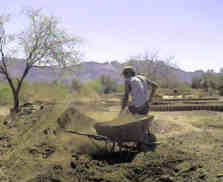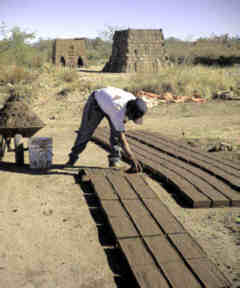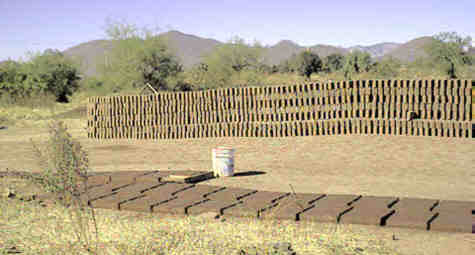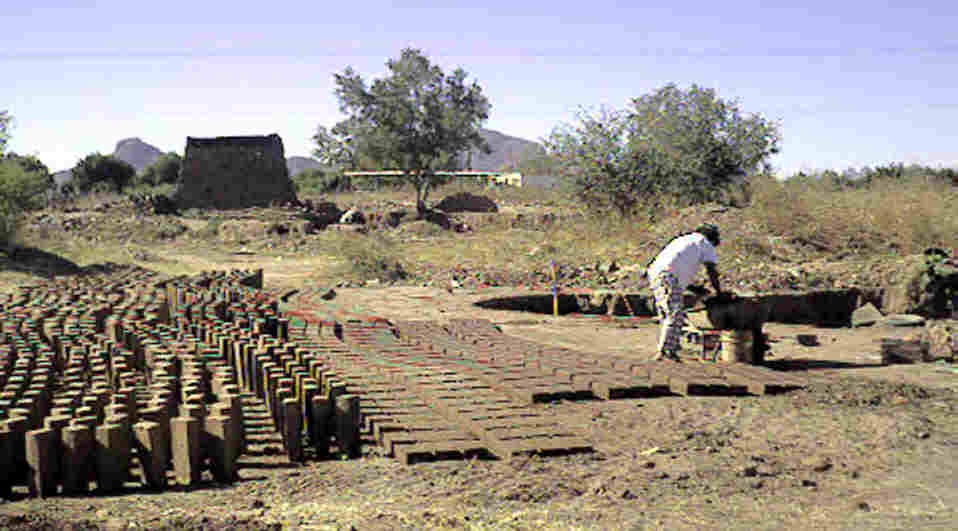Brick-Making in Mexico |
||
| Summer, 1999 |
| Some residents of San Carlos couldn't understand
why there was a shortage of bricks during the drought two summers ago. |
||
| Well, let's see -- not enough water to moisten
the clay for making bricks? Not enough wood to burn to fire the bricks?
Actually, not enough cattle to produce the necessary cow manure. |
||
| Another resident couldn't understand why there
weren't bricks available when she wanted them last summer. "They
said that it rained and ruined the bricks," she told me, and added,
"How can that be?" |
| When we have guests visiting us, I delight in taking them to see "The Brick Factory". I purposely don't tell them anything more than that we will visit the brick factory. | My sister, Martha, and her friend Heidi came last
Christmas vacation. That's when I took the pictures on this page. They simply could not believe what they were seeing. You may enjoy this picture story too. |
|
| My sister Dorothy and her two daughters visited this spring break. "Where's the cement?" Dorothy asked. "Surely they need cement to make bricks!" The pictures on the main page of the Summer Annalog were taken during Dorothy's visit. | No, Dorothy. No cement. The soil in Santa Clara is just the right consistency of clay that all they need is clay, cow manure, and water. |
| The picture on the right is from the main page. The worker is shovelling manure and clay into the wheelbarrow where he'll add water and mix the clay. Manure is used since it causes the bricks to become hotter during firing. |  |
|
 |
This form is used to make 4 bricks at a time. The bricks are then let to dry until they are hard enough to handle. The color remains a dull brown until after they are fired. |
 |
Clay for making bricks is in the wheelbarrow, the
white bucket contains water for smoothing the bricks, while the worker
fills a form to shape the bricks. The towers of bricks in the background are kilns built precisely so the heat circulates the bricks during the firing process. |
|
| When the bricks are dry enough to handle, they are set up in the sun to dry. Rather reminds me of the shocks of grain we had on the farm. Shocks were made too so that the grain would dry in the sun. |  |
|
 |
||
An overview of bricks in groups drying while others are stacked for drying completely hard. |
| Okay, maybe my calling it a "factory" is
misleading. What would you call it? Each worker makes about 200 bricks a day. |
 |
|
 |
 |
|
| I didn't get any really good pictures of the firing of the bricks. About 8,000 bricks are built into the kiln. The outside cracks are filled with mud. My guess is that the outside bricks are not as good quality as those inside the kiln. | Here you can see two openings in the kiln where the fire is built. The logs used for burning need to be brought in since there aren't large trees here that could be used for firewood. |
| If this looks hot, well it is. The bricks need to
be fired for 2 or 3 days. Someone stands guard over the fire 24 hours a
day. After firing, the bricks are the red color that we associate with bricks. |
 |
|
| Of course, before firing, a rain will ruin the "crop" of bricks since they would turn back to mud. |
 |
|
| Let me leave you with this picture of the Santa Clara Brick Factory. I gained an appreciation of the basic construction materials in Mexico. Making bricks in Mexico is a long, hot, dusty, tedious process. |
| If you would like to view all pages of the Summer news-magazine in the sequence listed below, just follow these blue arrows at the bottom of each page. |
| |Top of this Page| -- |Summer Annalog| -- |I've Been Thinking| -- |Living in Mexico| -- |Family News| -- |Spanish Study| -- | KN5000| -- |Recipes| -- |Photo Album| -- | Inspirational| -- | Women| -- | Remembering| -- |Books| -- |e-mail Anna| -- |e-mail Les| |